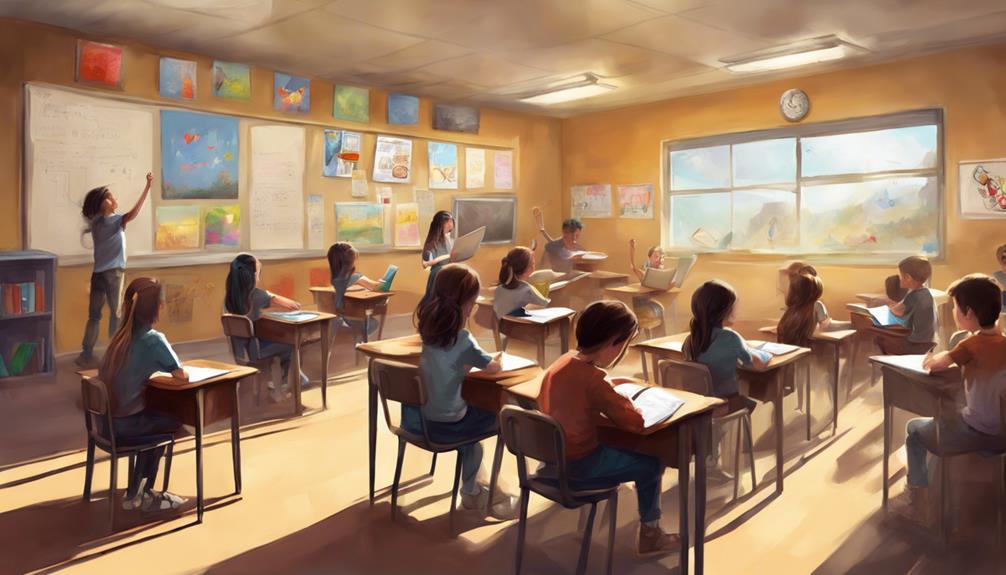In the realm of education, the concept of learning styles has long been a subject of interest and debate. As educators strive to cater to the diverse needs of learners, understanding how individuals process information is crucial. The question arises: Do learning styles significantly impact academic success, or are they merely a theoretical construct? By exploring the intricacies of learning style theory, we may uncover insights that challenge conventional wisdom and reshape how we approach teaching and learning.
Key Takeaways
- Learning styles involve preferences in how individuals process information.
- Visual learners benefit from visual aids like charts and diagrams.
- Auditory learners excel in understanding through discussions and lectures.
- Kinesthetic learners thrive with hands-on experiences and physical activities.
Understanding Learning Style Theory

Understanding Learning Style Theory involves analyzing how individuals process and organize information based on their preferences. Learning styles refer to the various ways in which learners prefer to approach learning tasks. These preferences influence how individuals perceive, interact with, and respond to learning materials in educational settings. Despite the widespread adoption of learning style models like VARK, which categorize styles as visual, aural, verbal, and kinesthetic, there is limited evidence to support the idea that tailoring instruction to match these styles leads to improved learning outcomes. Recognizing differences among students' learning styles remains important for educators, but it is essential to approach this concept with a critical mindset, considering the lack of concrete evidence linking specific teaching strategies to enhanced learning based solely on students' preferred styles. As the debate on the efficacy of accommodating learning styles continues, a more evidence-based approach to education may involve a broader consideration of diverse instructional methods that cater to a range of learning preferences.
Visual Learning Style
Visual learning style emphasizes the preference for information presented visually, such as through pictures and diagrams. Individuals with this learning style benefit from using visual aids like maps, charts, and graphs to grasp the connections between concepts. Incorporating color coding techniques and graphic organizers can significantly enhance the learning experience for visual learners.
Visual Aids Importance
Incorporating visual aids is pivotal for enhancing comprehension and retention among individuals with a visual learning style. Visual learners greatly benefit from the use of pictures, charts, and diagrams, which aid in understanding complex information and relationships more effectively. These learners respond well to visual representations, patterns, and shapes, making visual aids essential in educational environments. Flow charts and diagrams play a significant role in helping visual learners process and organize information. By utilizing visual aids, educators can improve the engagement, comprehension, and memory retention of visual learners during learning activities. The strategic inclusion of visual elements in lessons is instrumental in supporting visual learners in their academic journey.
Graphic Organizers Benefits
The utilization of graphic organizers significantly enhances the cognitive processes and information retention capabilities of individuals with a visual learning style. Visual learners benefit from graphic organizers in the following ways:
- Organize: Graphic organizers help visual learners structure and arrange information in a clear and systematic manner.
- Connect: They assist visual learners in linking related concepts and ideas through visual representations like diagrams and charts.
- Color Coding: The use of color coding in graphic organizers aids visual learners in better understanding and distinguishing different elements or categories.
These benefits support visual learners in processing complex information more effectively and facilitate a deeper comprehension of the relationships between various pieces of information.
Color Coding Techniques
Color coding techniques play a crucial role in enhancing the organization and retention of information for individuals with a visual learning style. Visual learners can effectively categorize and prioritize information by using different colors in notes or study materials. This method helps them make connections between concepts, leading to improved memory retention. By incorporating color-coded systems, visual learners can better understand complex topics and relationships. Utilizing color-coding in study strategies not only enhances engagement but also boosts comprehension of material. The table below provides a visual representation of how color coding can be utilized by visual learners to organize and categorize information effectively.
| Benefits of Color Coding for Visual Learners |
|---|
| Enhances organization of information |
| Improves memory retention |
| Facilitates categorization of data |
| Helps in making connections between concepts |
| Boosts comprehension of complex topics |
Auditory Learning Style
Through a focus on listening and oral communication, auditory learners excel in understanding concepts through discussions and lectures. This learning style involves processing information primarily through hearing and speaking. Verbal explanations and group activities play a vital role in aiding auditory learners to grasp information effectively. To support auditory learners in their educational journey, strategies such as repeating lessons, utilizing recordings, and engaging in group discussions are beneficial. These techniques cater to the auditory strengths of these learners by providing them with opportunities to reinforce learning through auditory stimuli. By actively participating in discussions and listening attentively to lectures, auditory learners can enhance their comprehension and retention of information. Embracing these methods tailored to their learning style can empower auditory learners to achieve academic success.
Kinesthetic Learning Style

Kinesthetic learning style emphasizes the importance of physical activities and hands-on experiences in the learning process. Individuals with this learning style thrive when they can engage in movement, touch, and manipulation to grasp and retain information effectively. Incorporating activities like experiments, simulations, and role-playing can greatly benefit kinesthetic learners by providing them with opportunities for active participation and real-world engagement.
Movement in Learning
Learning is significantly enhanced when incorporating physical movement and interactive tasks for individuals who prefer a kinesthetic learning style. Kinesthetic learners thrive in environments that offer hands-on experiences and opportunities for physical engagement. To cater to this learning style effectively, educators can implement the following strategies:
- Encourage interactive group activities that involve movement.
- Provide tools and resources that allow for tactile exploration.
- Incorporate physical exercises or gestures into lessons to reinforce learning.
Hands-On Activities
Incorporating hands-on activities is essential for catering to the kinesthetic learning style, as it allows individuals to engage physically and enhance their understanding through practical experiences and interactive tasks. Kinesthetic learners, who thrive on physical movement and experiential learning, benefit greatly from such approaches. Interactive simulations, role-playing scenarios, and engaging in experiments are particularly effective for this learning style. By actively participating in activities that involve touching, building, and manipulating objects, kinesthetic learners can grasp concepts more effectively. The incorporation of hands-on activities not only sustains their interest but also deepens their comprehension by providing tangible experiences that resonate with their learning preferences. This approach fosters a more holistic and engaging learning environment for kinesthetic learners.
Physical Engagement Benefits
Physical engagement plays a crucial role in enhancing comprehension and retention for individuals who exhibit a kinesthetic learning style preference. Kinesthetic learning involves active participation, movement, and hands-on experiences that cater to these learners' needs. To facilitate effective learning for kinesthetic individuals, engaging in tactile experiences and interactive tasks is essential. These learners excel when provided with opportunities for physical interaction with the material being learned. Incorporating movement into learning activities helps kinesthetic learners grasp concepts more effectively. Furthermore, hands-on experiences such as experiments, simulations, and role-playing activities are particularly beneficial for this learning style. By embracing physical engagement, educators can create a more inclusive and effective learning environment for kinesthetic learners.
Reading/Writing Learning Style

Individuals with a preference for the reading/writing learning style excel in tasks that involve consuming information in written form and engaging with text-based materials. This learning style is characterized by a strong inclination towards written assignments, statements, and text-based learning. Students who favor this style demonstrate proficiency in tasks that require reading, writing, and analyzing written content. They perform well on assessments and quizzes that involve written responses, showcasing their comprehension of textual information. For these individuals, describing complex concepts, charts, and diagrams in written form enhances their understanding. Tailoring learning activities to include written components can effectively engage and support learners with a reading/writing preference. By providing opportunities for these individuals to interact with written material, educators can optimize their learning experience and help them reach their full potential in academic settings.
Other Types of Learning Styles
Understanding the various types of learning styles is essential for educators seeking to cater to the diverse needs of their students effectively. Different students have unique preferences and ways of processing information, which can significantly impact their learning outcomes. Here are some other types of learning styles:
- Analytical learners: These individuals rely on logic and search for connections, causes, and patterns to engage in problem-solving activities effectively.
- Social/linguistic learners: Benefit from peer work, socializing, and group activities to enhance their understanding of subjects through interaction and communication.
- Solitary learners: Excel in individual work and prefer studying alone to focus on problem-solving tasks independently, often finding solitude conducive to their learning process.
Implementing SWOT Strategies

Exploring innovative educational approaches, the implementation of SWOT strategies offers a structured framework for enhancing study techniques across various learning styles. SWOT strategies encompass visual, aural, reading/writing, and kinesthetic approaches to cater to different preferences and optimize learning outcomes. By tailoring study methods to individual styles, students can maximize their understanding and retention of information. Utilizing visual strategies involves using tools like graphic organizers and color-coded materials to aid comprehension. Aural techniques include recording lectures or notes and engaging in discussions to reinforce concepts audibly. Read/write strategies focus on rewriting and organizing notes to enhance memory and understanding. Kinesthetic methods incorporate hands-on experiences and real-life examples to make learning more interactive and engaging. By strategically combining these strategies based on individual preferences, students can create a comprehensive study plan that aligns with their unique learning style.
| Learning Style | SWOT Strategies | Examples |
|---|---|---|
| Visual | Graphic organizers | Color-coding notes |
| Aural | Recording lectures | Engaging in group discussions |
| Reading/Writing | Rewriting notes | Organizing information logically |
| Kinesthetic | Hands-on experiences | Real-life application of concepts |
Enhancing Learning Outcomes
To optimize learning outcomes, tailoring instructional methods to align with diverse learning styles is a crucial factor in enhancing student engagement and comprehension. While it is debated whether matching teaching methods to specific learning styles directly improves learning outcomes, understanding learners' preferences and adapting instruction can foster better engagement and comprehension. Effective instruction also involves aligning teaching methods with the subject matter being taught to optimize learning effectiveness. Furthermore, including a variety of diverse activities such as visual, auditory, reading/writing, and kinesthetic tasks can benefit students by catering to individual learning styles and promoting a deeper understanding of the material. By considering the types of learning styles present in a classroom and incorporating varied activities that cater to these preferences, educators can create a more inclusive and effective learning environment that supports students in reaching their full potential.
Frequently Asked Questions
What Are the 4 Main Learning Styles?
The four main learning styles encompass visual learners, who grasp information best through visual aids like charts and diagrams, auditory learners, who excel through listening and verbal instructions, reading/writing learners, who thrive with text-based materials and written tasks, and kinesthetic learners, who benefit from hands-on experiences and physical activities. Understanding individual learning preferences and adapting teaching styles to accommodate these various modes of learning can enhance educational outcomes significantly.
What Is Meant by Learning Style?
Learning style refers to an individual's preferred method of processing information for learning. Understanding one's learning style, whether visual, auditory, or kinesthetic, allows for tailored instruction that aligns with their cognitive processes and preferences. By recognizing and accommodating diverse learning styles, personalized instruction can enhance comprehension and retention. Effective educational strategies should consider these variations to optimize learning outcomes for all individuals.
What Are 3 Main Types of Learning?
The three main types of learning include visual learning, auditory learning, and kinesthetic learning. Visual learners grasp concepts best through visual aids like pictures and diagrams. Auditory learners absorb information effectively through listening and discussions. Kinesthetic learners excel in hands-on experiences, learning by doing and touching. Understanding these learning styles aids in tailoring teaching methods to cater to individual student needs, whether in interactive, online, or traditional learning environments.
What Learning Style Is Most Effective?
When considering the effectiveness of learning styles, research suggests that personalized approaches incorporating cognitive preferences and technology integration can enhance learning outcomes. Visual, auditory, and kinesthetic techniques, when tailored to individual preferences, can promote active engagement and retention. However, it is essential to critically evaluate the evidence supporting the efficacy of specific learning styles to ensure instructional strategies align with the most current research findings.
Conclusion
In conclusion, understanding learning styles is crucial for educators to create inclusive environments, despite the lack of concrete evidence supporting tailored instruction to specific styles. By implementing SWOT strategies and focusing on enhancing learning outcomes, educators can cater to a diverse range of learners. Just as different tools are needed to fix a variety of objects, recognizing and adapting to various learning styles can lead to a more effective and engaging educational experience.
